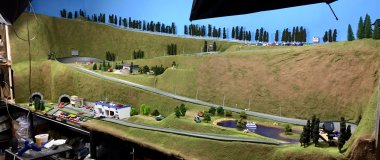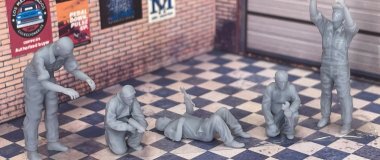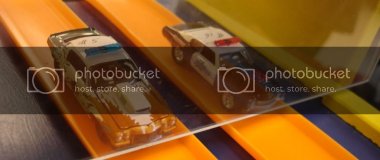From idea to retail, an interview with the inventor of TrackJack
Over the last 5 years or so, the diecast racing hobby has spawned a cottage industry of people designing and selling products for race tracks and modding. Largely thanks to 3D printing, we've seen all sorts of accessories like track pieces, finish line timers, and even scale figures for dioramas and more.
I threw my hat in the ring too, designing and selling an axle alignment jig to help in the car modding process. I learned a lot...how to create a model, print it, fulfillment, and marketing. It was fun and exciting to learn some new things but it was exhausting, and going beyond my basement was never really a goal.
But it was a goal for Mathew Georghiou at Klever Toys and one he achieved. His product, TrackJack, was an idea he came up with while playing with his son and ultimately got it manufactured as a retail product.
I got a chance to talk to Mathew about that journey and it's a story less about Hot Wheels racing and more about how a product goes from idea, to prototype, to a boxed product, which is something many of us are thinking about or trying.
What is TrackJack? It's a building system of interconnecting pieces to create support structures for race tracks. Great for hills, jumps, and even multi-level racing. You can read our TrackJack review here.
www.youtube.com/watch?v=0bymlc3C2cM
Interview with Mathew Georghiou from Klever Toys
The following has been lightly edited for clarity.
Redline Derby: Please introduce yourself with who you are, where you are, and what's your favorite breakfast cereal?
Mathew Georghiou: I’m Mathew Georghiou. I live and work in Nova Scotia, Canada. I don’t eat cereal :) I grew up eating bacon and eggs every day, but stopped eating breakfast many years ago.
RLD: I read in your bio that you immigrated from Cyprus to Canada when you were young. So where and when did Hot Wheels and diecast toy cars enter your life as a child?
MG: My earliest memory was when I was 5 years old — I fell into a coma (cause unknown). I came out of it quickly but had to recover in the hospital for a while. My mother would visit every day with a new dinky — I think they were mostly Matchbox at the time. I ended up with a good collection by the time I returned home.
RLD: What diecast racing have you been watching or participating in of late? The whole diecast racing hobby has grown a ton over the past few years. What are your thoughts on what you've seen so far?
MG: I watch these YouTube channels and other random videos— 3Dbotmaker, 4MadMovieMakers, Backyard Racing. I’m impressed by the well-produced and scripted racing videos and how people can mail in their cars for racing — very neat.
RLD: It sounds like you're a serial entrepreneur and all around "idea guy" that has come up with a lot of varied products, so what was the spark for TrackJack? Where'd that come from and what motivated you to pursue it beyond just an idea?
MG: My “coma” collection was my son Nico's first introduction to toy cars. And we started buying some Hot Wheels tracks and sets.
Nico loves Hot Wheels and asks me to build him an epic track every day (for years). We are always building unique race tracks for his cars — including weird Rube Goldberg style contraptions.

I love playing with Nico but it's frustrating to build a Hot Wheels track that actually works well. We have to move boxes and furniture and use tape and clamps to hold everything together. We spend too much time building the track instead of having fun racing and crashing the cars. And then we have to tear everything down so we can get our living room back.
For years, I searched for something that could help us build tracks better and easier but could not find anything. At first, I thought Nico might move on to other interests, but nope — he’s 14 now and still loves Hot Wheels. Nico also has Down Syndrome, so I suspect I will be building Hot Wheels tracks for the rest of my life.
So, I decided to try to fix this Hot Wheels problem for us. I thought maybe I could 3D print some parts or make them out of wood or something. After a bunch of prototypes, I came up with the current design.
I never intended to sell it, particularly since I’m so busy with my other businesses. But the prototype worked so well that I thought I really needed to make it available to other Hot Wheels enthusiasts around the world.
RLD: TrackJack is a wonderfully simple toy but I know there's a whole journey there with prototypes, focus groups, research, manufacturing, retail, etc. Can you give a quick peek into what the process is like for developing a toy like TrackJack?
MG: Yes, lots of work behind the scenes. I started by designing concepts on paper and then moved to creating the best one in 3D. I hadn’t done this type of 3D modeling before so I chose the free Tinkercad app since it was easy to learn.
I refined a prototype and had a friend 3D print it for me. This helped me identify various issues and I kept updating the design over several months. Eventually, I started 3D printing at a makerspace that had recently opened in my community. They had high-quality 3D printers for better prototypes.
The earliest prototypes looked very different than the ones [in the photo]. I had started with something smaller, thinking I could connect a bunch of them together, like LEGO, but I concluded that it would take too much time to build a track with a smaller piece, so I settled on the size and shape that I have now and added the ability to build multi-track racing.

The final design worked really well — even better than I had expected - so that motivated me to try to make it and sell it. But to do so, I had to get it manufactured with plastic injection molding. 3D printing was not strong enough and far too slow and expensive when you need thousands of an item. So, I researched manufacturers and settled on one to make it for me.
Then I had to come up with a product name, business name, messaging, packaging, bar code, trademark registrations, patent applications, websites, ecommerce, video production, accounting systems, child safety testing, and more.
Even though I’ve done all of these things before, it takes a lot of time and focus, and I’m a bit of a perfectionist so that added to the level of effort — and stress.
I did not do any focus group testing. I did not do a launch event. I just quietly made the product available for sale and have been slowly creating awareness where I now feel I’m seeing good momentum.
RLD: Did you ever pitch TrackJack to Mattel or any other big toy company? Is that type of goal always in the back of your mind, to just sell the idea/product, or do you like having more control over your creations?
MG: I have not pitched Mattel because their new invention submission process is problematic. I would love the opportunity to do so under the right circumstances. A couple of other toy companies have seen TrackJack but through inventor relations people, not me directly.
I have not yet done a licensing deal with a toy company, but with another of my businesses I have done software licensing deals with the largest educational publishers in the world. I learned a lot from that experience.
For some of my products, I prefer to have control over how they are sold. For others, I would prefer to find someone to license the product and send me royalties. There are lots of variables at play.
RLD: Diecast racing has made for quite the cottage industry of people creating track accessories, mostly thanks to the accessibility of 3D printing. Being someone that has been developing products for many years, what are your thoughts on how something like that has changed/impacted the business of inventing and ideas? What other things have really changed what you do for the better (or for worse)?
MG: 3D printing is definitely a game changer. It made it easier for me to invent TrackJack. And, I recently 3D printed 20,000 parts for a new board game that I wanted to test.
Another thing that has made inventing easier is the ability to find manufacturers around the world that can make anything — and do so affordably. That was much more difficult and time consuming previously. Today, I can find a manufacturer and have my design in their hands within a few days. And my payments to the manufacturers can be insured in case they don’t deliver as promised.
The ability to sell products online and via Amazon and other retailers has helped. Fulfillment services are very convenient, as is fast shipping.
What is problematic is the amount of competition for customer attention. Marketing can be very time-consuming and expensive — and unprofitable for a product that is priced in the tens of dollars.
And shipping costs have become very expensive. Some of my newer products cost more to ship than to make. At lower volumes, shipping eats up all profits.
Inventing and commercializing a new product can be lots of fun and stressful too.

RLD: And for all the RLD members that are inventing products and just doing it out of their home...what insight or tips can you give to someone looking to take their ideas out of the basement and be something bigger?
MG: Today, it’s easier and more affordable than ever to commercialize an invention. And there is lots of free information available on how to do it. My advice is to start learning how to do it and pick away at it. Learning how to commercialize your own invention and taking steps to do it can be really fun — even if you decide not to sell it.
Be sure to also assess the financial viability of your invention before you spend thousands of dollars on it. Don’t fall in love with it so much that you lose your ability to assess the market reality. That’s where a lot of inventors fail.
And, be careful of scammers who will try to trick you into spending money on things you may not need.
RLD: One thing that comes up often in discussions at Redline Derby is wishing toy companies, like Mattel, would create and release items/packs/lines that cater more to the racing crowd.
Obviously, diecast racing is a niche in a niche, and we all understand that big business looks at economics first, but based on your experience, what is a good way to get the Big Boys to hear customer ideas? Is it sending them a lot of emails, or is it just dumb luck in hoping someone sees something online and passes it on?
MG: Some toy companies have a process for accepting new inventions, so that’s one place to start — although these processes sometimes do not work well. Be sure to review any terms and conditions before submitting.
Much of business is about relationships. Being able to connect with the right person at the right time who is willing to listen. That’s really hard to do these days when everyone is barraged with so much information and often unwilling to engage with anyone they do not know and trust.
If you don’t have that trusted relationship then you can try to ask someone who does to make an introduction for you. This might be someone in your personal network or an “inventor relations” agent or distributor.
If you have to go in cold, there are some strategies you can try that take a lot of time or cost a lot of money with no guarantee of success.
And if you do manage to make the pitch, then the economics and other factors come into play. Small financial opportunities are not of interest to big companies, unless there is strategic value for them.
And a big part of business success is timing and luck. Being at the right place at the right time — so luck does play a role for sure.

RLD: Do you consider TrackJack a successful product? Are you happy with how it has performed?
MG: I consider it a success in terms of how well it has worked in achieving my original objective to make it easier and more fun to build Hot Wheels tracks. In terms of financial success, it’s too early to tell, but I feel the momentum is heading in the right direction.
RLD: I don't see any other diecast-related products from Klever Toys. Is TrackJack a one-off thing or do you have plans to make more products for the diecast toy market? Maybe something aimed at us racers?
MG: I do want to develop more products under Klever Toys. I had an idea for another Hot Wheels product but Mattel beat me to it. And I do have another one for Hot Wheels racing using RC cars — but it’s going to take me some time to get to it. Recently, I was noodling some ideas about a wide track that I think Hot Wheels racers are looking for.
RLD: What new products/ideas are on the way that you can talk about? What can we look forward to seeing and trying? Toys, games, podcasts, books, whatever…
MG: I’m always working on several projects at the same time. Some I pick away at for years while others I dedicate more time and resources to complete quickly. Right now, I’m working on a unique board game that combines gameplay with puzzle pieces, another board game to teach personal finance, a software-based simulation to teach project management, and some research on Artificial Intelligence.
More about TrackJack
I'd like to thank Mathew for taking the time to chat and share a bit of the TrackJack story.
Visit the TrackJack website for more info and videos. You can buy TrackJack on Amazon.





Thanks for sharing my TrackJack story :-)